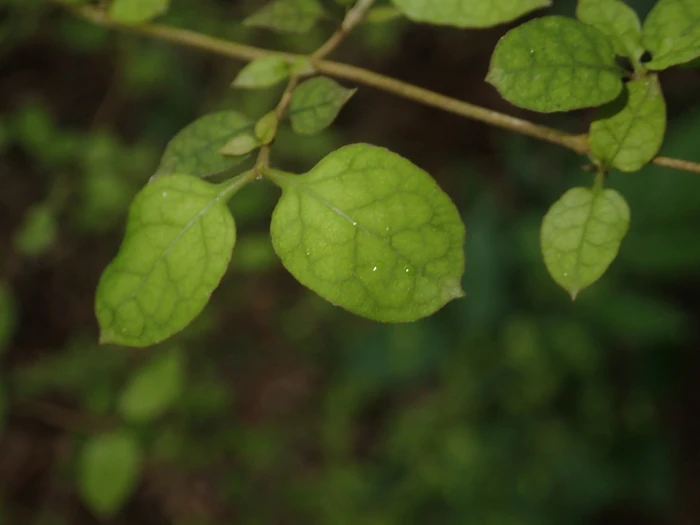Thin-Leaved Coprosma
(Coprosma areolata)
Thin-Leaved Coprosma (Coprosma areolata)
/
/

Tony Wills
CC BY-SA 4.0
Image By:
Tony Wills
Recorded By:
Copyright:
CC BY-SA 4.0
Copyright Notice:
Photo by: Tony Wills | License Type: CC BY-SA 4.0 | License URL: http://creativecommons.org/licenses/by-sa/4.0/ | Rights Holder: Tony Wills | Publisher: iNaturalist | Date Created: 2021-10-24T10:14:47-07:00 |



















































Estimated Native Range
Climate Requirements
| • Precipitation | 53" - 64" |
| • High Temp. | 64°F - 75°F |
| • Low Temp. | 34°F - 45°F |
Summary
Coprosma areolata, commonly known as Thin-Leaved Coprosma, is a shrub native to the forest margins, scrubland, and river terraces of New Zealand. It is an evergreen plant that typically grows to a height of 3-13 feet (1-4 meters) with a similar spread. The species name ’areolata’ refers to the net-like venation on the leaves. The leaves are small, narrow, and have a glossy appearance, which contributes to the plant’s visual interest throughout the year. Coprosma areolata does not produce showy flowers; instead, it bears inconspicuous greenish-white blooms followed by orange-red berries that are attractive to birds.
Thin-Leaved Coprosma is valued for its dense, fine-textured foliage and its ability to adapt to a range of conditions, making it suitable for use as a hedge or in mixed shrub borders. It is also used for revegetation projects due to its resilience. This Coprosma prefers well-drained soils and can tolerate both full sun and partial shade, making it versatile for garden design. While it is relatively low-maintenance, it may require some pruning to maintain its shape and can be susceptible to scale insects and root rot if conditions are too wet. It is not known to be invasive outside its native range, but gardeners should always monitor non-native plants for unexpected spread.CC BY-SA 4.0
Thin-Leaved Coprosma is valued for its dense, fine-textured foliage and its ability to adapt to a range of conditions, making it suitable for use as a hedge or in mixed shrub borders. It is also used for revegetation projects due to its resilience. This Coprosma prefers well-drained soils and can tolerate both full sun and partial shade, making it versatile for garden design. While it is relatively low-maintenance, it may require some pruning to maintain its shape and can be susceptible to scale insects and root rot if conditions are too wet. It is not known to be invasive outside its native range, but gardeners should always monitor non-native plants for unexpected spread.CC BY-SA 4.0
Plant Description
- Plant Type: Shrub
- Height: 10-12 feet
- Width: 5-6.5 feet
- Growth Rate: Moderate
- Flower Color: N/A
- Flowering Season: Spring
- Leaf Retention: Evergreen
Growth Requirements
- Sun: Full Sun
- Water: Medium
- Drainage: Slow, Medium
Common Uses
Bird Garden, Edible*Disclaimer: Easyscape's listed plant edibility is for informational use. Always verify the safety and proper identification of any plant before consumption., Low Maintenance
Natural Habitat
Forest margins, scrubland, and river terraces of New Zealand
Other Names
Common Names:
Scientific Names: Coprosma areolata, Coprosma multiflora
GBIF Accepted Name: Coprosma areolata Cheeseman